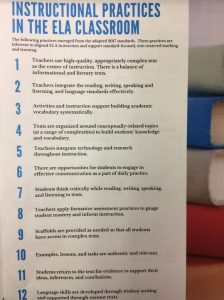I attended a workshop from the NC Department of Public Instruction on the upcoming new ELA Standards for 2018. This supporting document was given and as I looked at it–a few stood out as thoughts to ponder in regards to how it affects our school.
 From NCDPI. Published on their website and livebinder. See this link for the information found in this document. Link to NCDPI Livebinder.
From NCDPI. Published on their website and livebinder. See this link for the information found in this document. Link to NCDPI Livebinder.
Numbers 1-3 were simply reminders of the things we do everyday.
- informational and literary text (50-50) at heart of instruction
- integration of listening, speaking, reading and writing
- systematic vocabulary instruction
Number 4: Texts are organized around conceptually-related topics (at a range of complexities) to build students’ knowledge and vocabulary. The words “organized around conceptually related topics” made me think about how we choose our text. Are these related topics or our social studies and science? Are these related texts both pairing informational and literature on the same topic? I am not sure we are thinking through our units to this depth to ensure the ideas we are teaching cross a range of complexities and using vocabulary in different ways with different genres.
What can we do?
Create text sets. I know we talked about this five years ago when Common Core came on the scene but did we understand it? We need to create our units that use similar vocabulary across the different genres for students to see these words in different contexts. In addition, we must increase and manipulate the complexities both through choice of Lexile AND the qualitative measures the text possesses.
Number 5 and 6 seem to pair nicely.
- integration of technology
- opportunities to communicate daily about what they are learning
Number 7: Students think critically while reading, writing, speaking and listening to text. Think critically does not simply mean answering questions. Think critically means to make decisions, create arguments and defend ideas. Are we going this deep?
What can we do?
Ask meaningful questions that require students to synthesize information and to think using the text in various places as well as their schema to answer questions. Pose questions or statements for students to defend or disprove. Finding mistakes in other’s work or finding evidence for ideas helps students critically think about information and weigh the quality of this information. This type of thinking does go on occasionally but do we do this daily? An increase in this type of thinking will encourage deeper reading naturally.
Number 8 which is apply formative assessment practices to gauge student mastery and inform instruction. This practice directly correlates with our school Benchmark scores. Those teachers who use their data and drive instruction with it–yield the highest results.
Number 9 which is scaffolding as needed for all students. Please remember this means to provide it AS NEEDED! AS A STAFF WE HAVE LEARNED TO CONTROL THIS–RIGHT??? Think on our PD and what you have learned about how to control rigor. What scaffolding is in place– who is your learner?? What truly needs to be applied to stretch that student.
Number 10 and 11 are used daily and is probably our strength as a school. Think text dependent questioning and making strong authentic examples and relevant connections.
- students returning to text for evidence to support ideas
- examples, lesson and tasks are relevant and authentic
Finally, Number 12, skills are developed in writing. NOT Usually!!!
What can we do?
Start small with student reflections and quick writes on topics you are discussing. These opportunities open up writing for students without worrying about punctuation, sentence structure and grammar. Sometimes these hold our students back from trying. Get the ideas down AND then start work on editing and improving their ideas.
This list is not earth shattering BUT is a good reminder of what our ELA classes should look like on a DAILY basis. We are solid with our instruction in some areas but need to really examine the ideas in the others. As a staff, I challenge you to think about which ones you feel need to be strengthened. Choose one to begin with and take small steps towards mastering it.